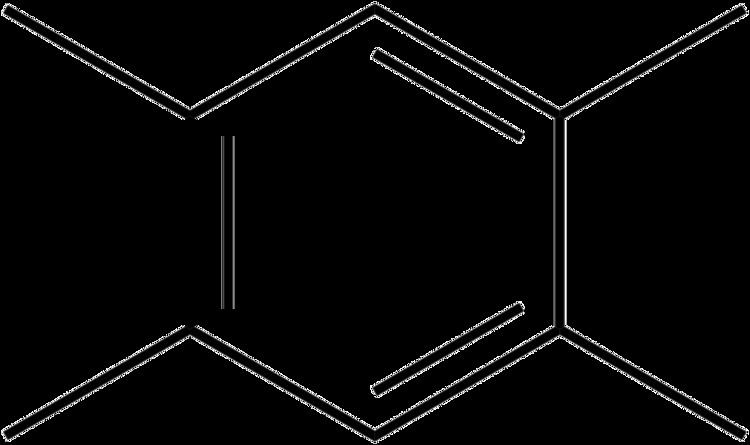Formula C10H14 Boiling point 192 °C | Melting point 79.2 °C Density 868 kg/m³ | |
 | ||
Durene, or 1,2,4,5-tetramethylbenzene, is an organic compound with the formula C6H2(CH3)4. It is a colourless solid with a sweet odor. The compound is classified as an alkylbenzene. It is one of three isomers of tetramethylbenzene, the other two being prehnitene (1,2,3,4-tetramethylbenzene, m.p. −6.2 °C) and isodurene (1,2,3,5-tetramethylbenzene, m.p. −23.7 °C). Durene has an unusually high melting point, reflecting its high molecular symmetry.
Contents
Production
It is a component of coal tar. It is produced by methylation of other methylated benzene compounds such as p-xylene and pseudocumene.
C6H4(CH3)2 + 2 CH3Cl → C6H2(CH3)4 + 2 HClIn industry, a mixture of xylenes and trimethylbenzenes is alkylated with methanol. Durene can be separated from its isomers by selective crystallization, exploiting its high melting point. The original synthesis of durene involved a similar reaction starting from toluene.
Durene is a significant byproduct of the production of gasoline from methanol via the "MTG (Methanol to Gasoline) process".
Reactions and uses
Durene is an electron-rich arene, exhibiting nucleophilicity comparable to that of phenol. It is readily halogenated on the ring for example. Nitration gives the dinitro derivative, a precursor to duroquinone. In industry, it is the precursor to pyromellitic dianhydride, which is used for manufacturing curing agents, adhesives, coating materials. It is used in the manufacture of some raw materials for engineering plastics (polyimides) and cross-linking agent for alkyd resins.
With a simple proton NMR spectrum comprising two signals due to the 2 aromatic hydrogens (2H) and four methyl groups (12H), durene is used as an internal standard.
Safety
Durene is relatively toxic for an aromatic hydrocarbons, which tend to have low acute toxicities. The LD50 for intravenous exposure in mice is 180 mg/kg.
